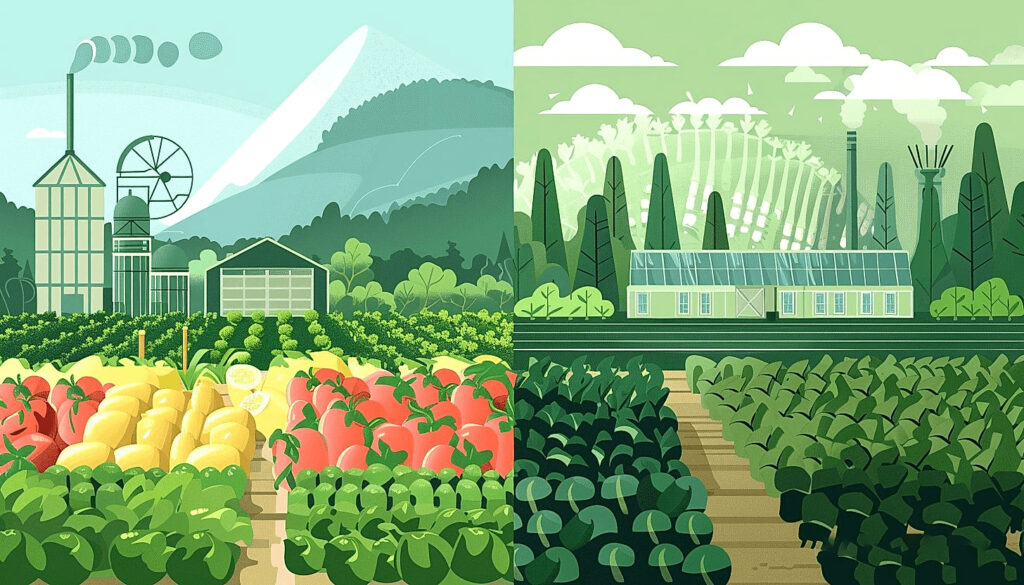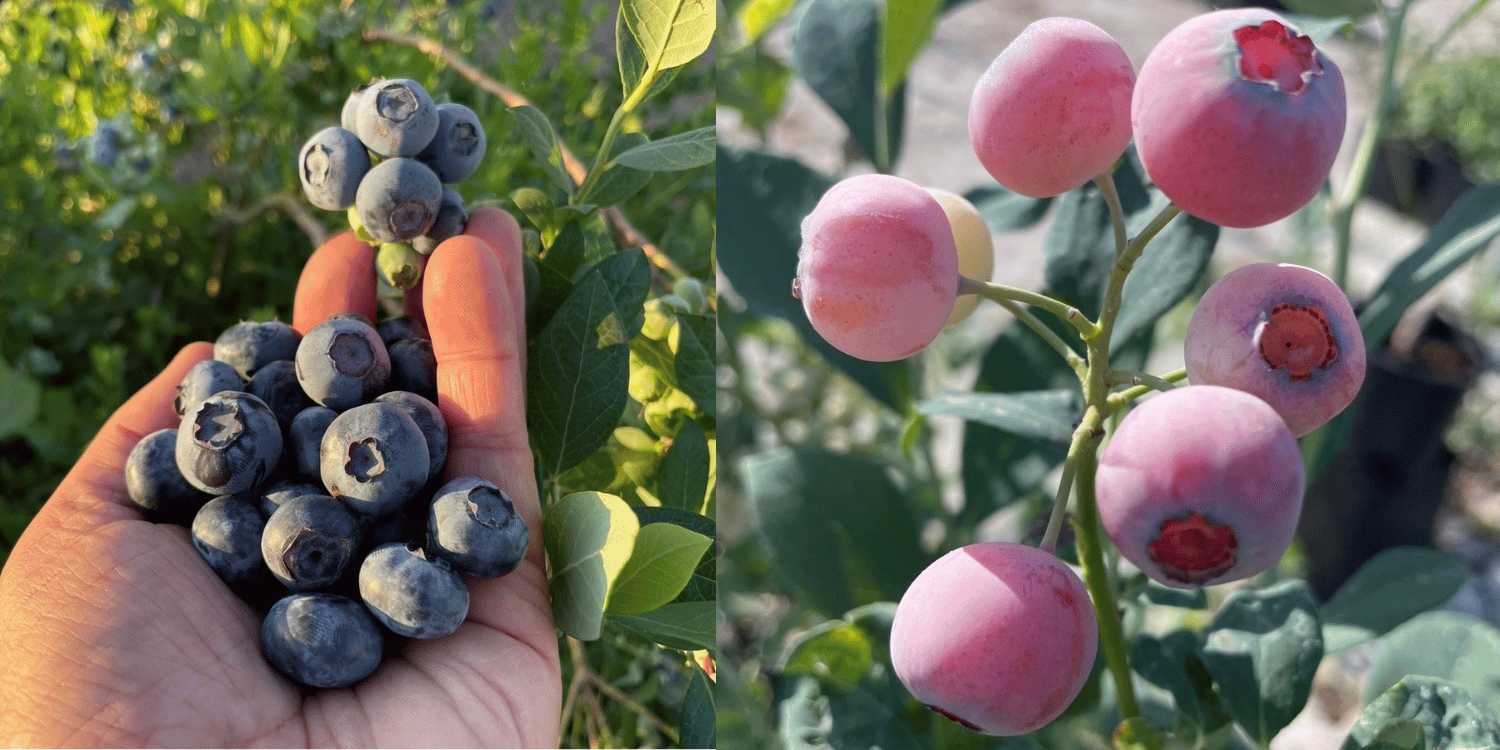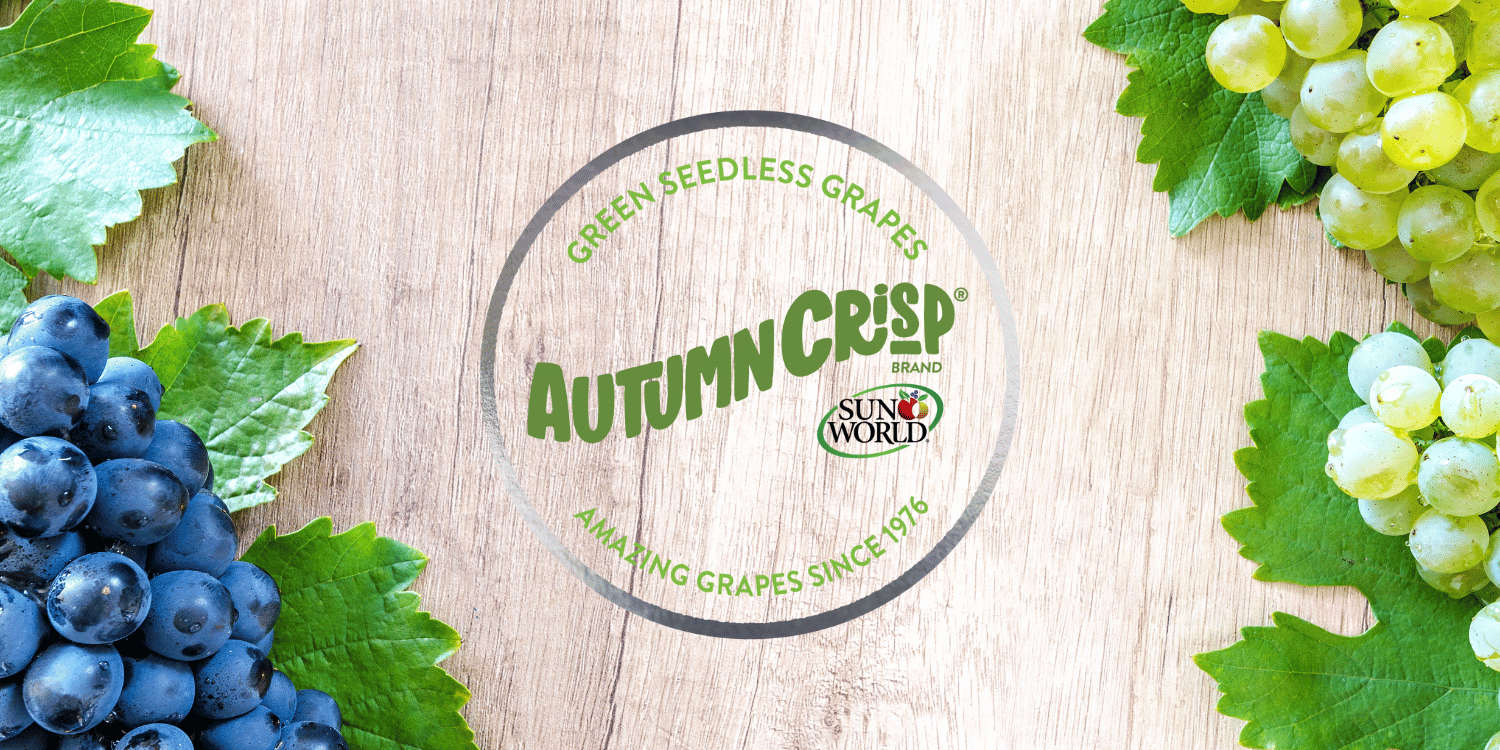The organic versus conventional produce debate pivots primarily on health implications, environmental impact, and cost considerations.
Organic produce is argued to be better for one’s health, containing fewer pesticides and potentially more nutrients, although research results are not entirely definitive.
In terms of environmental impact, organic farming tends to be more beneficial as it can enhance soil fertility, and it reduces the pollution of groundwater with synthetic pesticides and fertilisers.
However, conventional farming is often more cost-efficient, usually yielding larger quantities of crops and thus commanding lower market prices than organic products.
Many also argue that modern conventional farming methods can be sustainable, and that they are necessary to feed a growing global population.
In the end, the choice between organic and conventional produce often comes down to personal preference, with factors such as budget, health perceptions, and environmental consciousness playing a significant role.
- Definition and benefits of organic produce consumption explored.
- Pesticides prevalence in conventional produce discussed.
- Comparison of nutrient values in organic versus conventional produce.
- The environmental impact of organic farming is assessed.
- Exploration of the cost and sustainability of organic and conventional farming.
Organic and conventional farming practices present a multi-faceted topic worth exploring further. As we dig in into following sections, I will provide deeper insight into key issues; including the economic viability for farmers, and the influence of these farming methods on our health.
You will gain an understanding of the potential implications behind your choice at the grocery store. Stay with us as we continue to pull back the layers of this conversation to give you the comprehensive understanding you need.
The forthcoming information is not only essential for making informed consumption choices, but also for understanding the larger picture of sustainability and health in the context of our global food system.
Let us continue to explore this complex topic, using simple and digestible language, to empower an informed decision-making process on your part.
Contents
- What Defines Organic Produce?
- Benefits of Organic Produce Consumption
- Pesticides in Conventional Produce
- Nutrient Comparison: Organic vs Conventional
- Environmental Impact of Organic Farming
- Costs Associated with Organic Produce
- Can Conventional Farming Be Sustainable?
- Factors Influencing Consumer Choices
- The Bottom Line
What Defines Organic Produce?
In Short: Organic produce is defined by internationally recognized farming practices that avoid synthetic chemicals and prioritize conservation, biodiversity, and animal welfare. The whole supply chain, not just the farming process, must adhere to these standards, with organic goods kept separate from non-organic ones to maintain their integrity.
When we dig in into the subject of organic produce, what concepts tend to come to mind? Perhaps you picture farmers cultivating their crops away from synthetic pesticides and chemicals?
Naturally, this image is not far from the truth. Organic produce is, indeed, grown under specific agricultural practices that differ significantly from conventional methods.
There are clear, internationally recognized standards that outline what constitutes organic farming. Will it surprise you to know that the growers must fulfill these rigorous criteria to label their goods as organic?
Shall we understand what defines these guidelines? The key defining elements are addressed on the following points:
- No use of synthetic herbicides, pesticides, or fertilizers.
- A focus on conservation and biodiversity in the farming process.
- The use of crop rotation or other forms of natural farming enhancement.
- Emphasis on animal welfare when products involve livestock.
Promotion of biodiversity and effective resource use are fundamental principles ingrained within the organic movement. Did you realize that soil management is also a very significant element of organic farming standards?
Soil fertility plays a significant role, which is enhanced through natural processes such as crop rotation. Is it not fascinating how organic farming takes advantage of the sophisticated ecosystem present in the soil?
It’s also beneficial to bear in mind that organic does imply more than just the farming process. Do you realize that the whole supply chain, from harvest to your table, also needs to comply with organic standards?
Each step in the supply chain must ensure that organic produce is kept separate from non-organic produce. Doesn’t this emphasize the commitment to providing truly organic goods to consumers?
Furthermore, livestock in organic farms is nurtured by rearing with natural behaviors in mind to ensure sustaining their lifecycle. It isn’t upsetting to comprehend how most industrial farming methods can disregard this factor?
Lastly, any packaged organic food product should identify its certification body. Would you have thought that this verification is the final evidence of its organic label?
By now, you have a solid comprehension of what defines organic produce. Isn’t it fascinating how these careful practices can culminate into the organic apple in your fruit bowl?
Benefits of Organic Produce Consumption
In Short: Organic produce not only contributes to a healthier lifestyle, it’s also better for the environment, fresher, safer to consume, and nutrient-rich, with a better taste. When you choose organic, you support sustainable farming methods that reduce pollution, conserve water, increase soil fertility, and use less energy, aiding in climate change mitigation.
Do you know the wonderful benefits that consuming organic produce brings to our bodies? Not only does it contribute to a healthier lifestyle, it also impacts the environment positively.
Organic foods are often fresher, as they lack the preservatives that allow items to sit on shelves for a long period. The absence of pesticides, hormones and antibiotics also makes them safer to consume. Do you want to load your body with toxic chemicals?
They are also more packed in nutrients, according to numerous studies. For instance, it was found that organic milk contains about 50% more omega-3 fatty acids compared to conventional milk.
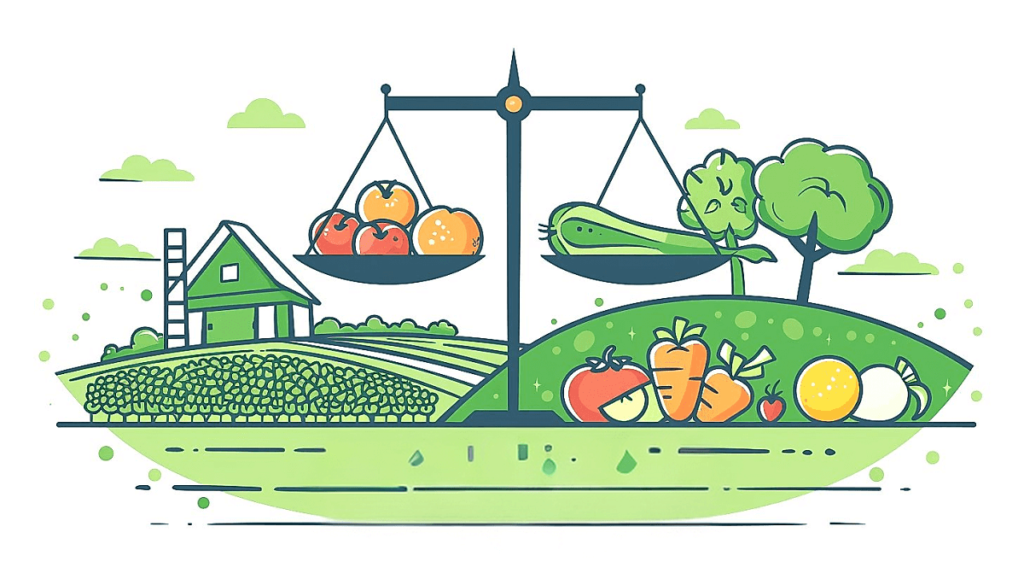
Speaking of nutrients, let’s break it down. Here are some nutrients that are found in higher quantities in organic produce:
- Antioxidants: These substances help in reducing the risk of chronic diseases by preventing or slowing the damage to cells.
- Omega-3: A type of fatty acid that has heart health benefits.
- Vitamin C: Not just for colds, it contributes to skin health and immunity.
- Phytochemicals: These compounds have health-protecting qualities.
Now, isn’t it exciting and reassuring to know exactly what nutrients are going into your body? Let’s discuss yet another organic produce advantage: enhanced taste.
Many people have reported that organic products have a stronger and sweeter taste compared to conventional ones. Organic farming often leads to more use of natural fertilizers that enhance the health and taste of the produce.’
This also influences the balanced sectors within, for example, the wine industry. Many wine connoisseurs suggest that organic grapes produce a much richer and complex flavor profile.
Moreover, by choosing organic, you’re supporting small and local farmers. These farmers use sustainable methods that don’t harm the environment. Doesn’t that feel like a cause worth standing behind?
Finally, organic farming practices can help mitigate the effects of climate change. They not only reduce pollution, they also conserve water, increase soil fertility, and use less energy. How’s that for a step towards a healthier planet?
The benefits of organic produce consumption are beneficial to your health and for the sustainability of the mother Earth. However, is it always available and accessible to all? We will discuss this aspect in the upcoming section.
Pesticides in Conventional Produce
In Short: Pesticides, including herbicides, insecticides, and fungicides, are extensively used in conventional farming to improve crop yield, leaving residue on produce which is regulated by the U.S. Environmental Protection Agency.
When considering conventional produce, pesticides are often the most controversial topic. They’re used extensively in traditional farming to protect crops from insects, diseases, and pests.
Pesticides come in a variety of forms, including herbicides, insecticides, and fungicides. Each has a different purpose, but all are designed to improve crop yield by preventing damage from pests.
Now, what about the presence of pesticides in the fruits and vegetables we buy? It’s a common belief that all conventionally grown produce is saturated with harmful chemicals.
Is this always the case though? Well, the level of remaining pesticide residue can vary widely.
The strict regulations set by the U.S. Environmental Protection Agency (EPA) ensure that the residues left on produce are well below the levels considered to be harmful. Nevertheless, traces of these chemicals remain on many conventionally-grown fruits and vegetables.
Certified organic foods, on the other hand, use natural pesticides rather than synthetic. This addresses the pesticide issue but is it the perfect solution?
No farming method, conventional or organic, can absolutely guarantee zero pesticides. But are these residual traces on our foods really a reason to worry?
The health impact of consuming these small amounts of pesticides is not fully understood. Studies offer contradicting results: some suggest even low-level exposure can increase risk of certain illnesses, others indicate these traces are harmless.
Let’s further explore the central reasons for concern about pesticide exposure through a quick list:
- Chronic health issues: Constant low-level exposure could contribute to certain chronic health problems.
- Impact on developing children: Children might be more vulnerable to the effects of pesticide exposure.
- Compound effect: Combining different pesticides could potentially increase their individual effects.
It’s worth noting that washing and peeling fruits and vegetables can help remove some pesticide residues. However, certain pesticides are absorbed into the produce and can’t be completely removed through cleaning.
At the end of the day, the decision to choose organic or conventional produce hinges on personal values. Are you comforted by the strict regulations for pesticide applications and residue levels, or do you prefer to opt for organic strategies and accept potential trade-offs such as higher prices or imperfect produce?
Whatever your choice, it’s crucial to incorporate a diverse array of fruits and vegetables into your diet. After all, the benefits of consuming enough produce — whether conventionally or organically grown — are well established.
Nutrient Comparison: Organic vs Conventional
In Short: Organic produce may have a slight nutritional edge over conventional produce due to higher levels of certain essential nutrients. However, the minor differences in nutrition levels are unlikely to significantly impact general health, and other factors like quality, taste, pesticide residue, environmental impact and price should be considered when choosing produce.
One critical aspect many consider when debating between organic and conventional produce is the matter of nutrients. Is one more nutritious than the other?
This is a frequently asked question by consumers, especially those pursuing a healthier lifestyle. Indeed, consuming more nutrient-rich foods can greatly boost our overall health.
The intriguing factor in this debate is that both organic and conventional produce each have their unique attributes. Do these attributes affect their nutritional content?
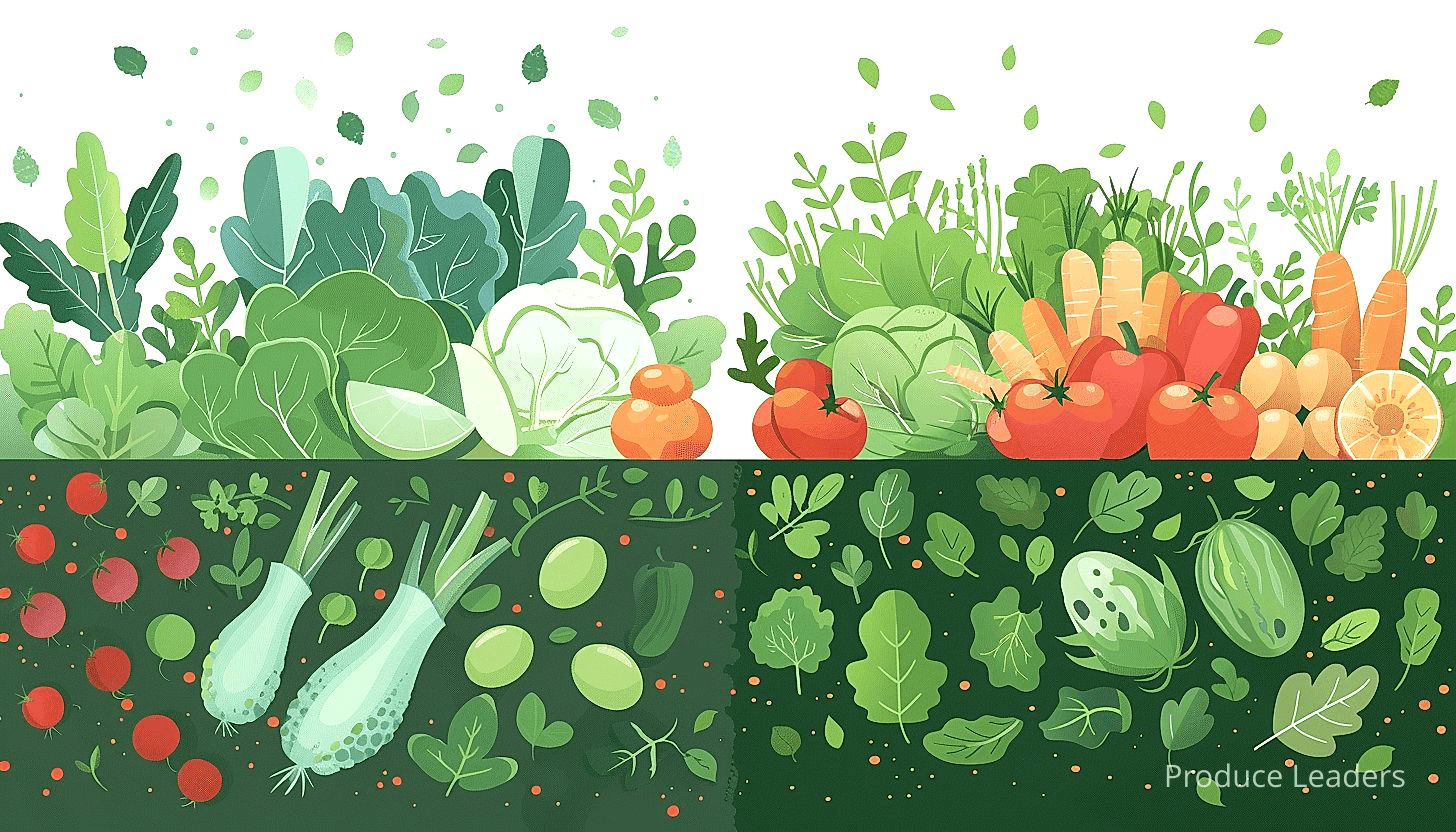
The answer can prove to be rather complex due to various factors at play, most notably soil quality, farming practices, and the crop’s nature. How then can we compare these two categories?
Let’s talk more about the nutrient comparison, guided by recent scientific research. This includes consideration of the macronutrients (carbohydrates, proteins, and fats) and micronutrients (vitamins and minerals).
Before exploring each type’s specifics, it’s important to highlight some factors that affect nutrient levels in both organic and conventional produce.
An understanding of these factors can broaden our knowledge on the topic:
- Soil Quality: Both organic and conventional produce nutrients can be affected by the region’s soil health.
- Harvesting Time: Harvesting produce at the right time is crucial in preserving nutrient levels.
- Storage Conditions: How a product is stored post-harvest can either preserve or decrease its nutrient content.
- Farming Practices: Different farming practices can impact the richness and abundance of nutrients in any produce.
This means that the time, place, and method of production can influence the nutritional value of any given produce, whether organic or conventional.
According to several researchers, there is a slight nutritional edge that organic produce has over its conventional counterpart. Is that true for all nutrients?
Not necessarily. Some studies have shown that organic produce tends to have higher levels of certain essential nutrients like antioxidants.
Still, it’s worth noting that any differences in nutrient content tend to be small, and their health impact is still a topic of debate. Who’s to say the small differences make a large impact on our health?
Contrarily, some suggest that conventional farming – with its use of synthetic fertilisers and pesticides – can cause produce to have slightly lower nutrient levels. But is conventional produce really significantly less nutritious?
A significant number of researchers argue against this claim, stating that these minor differences in nutrition levels are unlikely to impact our general health significantly.
However, it’s crucial to remember that produce’s nutritional value isn’t the sole factor to consider when choosing between organic and conventional. What are the additional factors to consider?
Quality, taste, pesticide residue, environmental impact, and price are few to mention. Keep in mind, the healthiest produce for you is the one that you’ll actually eat.
Getting a balanced, varied diet filled with fresh, whole foods – whether those are conventional or organic – is what truly counts. Isn’t balanced nutrition the key to a healthier life?
Environmental Impact of Organic Farming
In Short: Organic farming plays a pivotal role in promoting environmental sustainability by utilizing natural pest management and organic fertilizers, enriching soil health, conserving water, and aiding carbon sequestration. However, it’s not a cure-all solution as it can require more land, the organic labeling varies dramatically across countries, and the transportation distance can still contribute to carbon emissions.
When discussing organic farming, one cannot overlook its crucial role in promoting environmental sustainability. Organic farming practices, in essence, aim to reduce the harmful effects of agriculture on the environment.
Do you know about the impact of chemical pesticides and synthetic fertilizers? These are standard in traditional agriculture, but they are harmful to the environment.
In sharp contrast, organic farming employs natural pest management techniques and organic fertilizers. This results in fewer toxic chemicals entering the soil and water systems.
Can you visualize a farm teeming with biodiversity, rather than a monoculture stretching to the horizon? Yes, such a view can be quite refreshing. Organic farms often cultivate a variety of crops, rather than focusing on a single type, which promotes biological diversity.
I’ll list some other ways organic farming contributes to environmental sustainability.
- Soil health: Organic farming practices like crop rotation, composting, and cover cropping enrich the soil fertility over time.
- Water conservation: Organic practices enhance soil structure and water-holding capacity, thus promoting water conservation.
- C02 Sequestering: Through increased biomass and less energy use, organic farming systems can potentially sequester carbon dioxide, aiding in the fight against climate change.
But it is essential to note that organic farming is not a silver bullet that will solve all environmental issues associated with agriculture. Organic farming methods can require more land than conventional farming.
Just think about it, more land means less space for natural, untouched ecosystems, doesn’t it? Yes, it does pose potential challenges for biodiversity.
Organic labeling is another point of contention. It may seem that every piece of produce with an organic label is a result of sustainable practices, but is it so?
Regulations defining what can be labeled organic can vary significantly from country to country. Consequently, the environmental benefits of organic produce might not be as clear-cut as one might hope.
And let’s not forget about food miles. It refers to the distance food travels from its place of origin to your plate. Even if a product is organically grown, long transport distances can contribute to its environmental footprint.
Pro Tip: Organic farming practices aim to reduce the harmful effects of agriculture on the environment, employing natural pest management techniques and organic fertilizers which result in fewer toxic chemicals entering the soil and water systems, and often promote biological diversity.
You probably didn’t think that buying that organic apple from a neighboring country could have contributed to carbon emissions, did you? It’s a complexity that we have to consider while discussing organic farming.
In the grand debate between organic and conventional agriculture, understanding the environmental impact of organic farming is a significant part. And now that we’ve scratched the surface of this topic, it’s clear that it’s no simple issue.
Costs Associated with Organic Produce
In Short: Organic produce is typically costlier due to factors like smaller farm sizes, labor-intense practices, organic certification, and higher costs for organic seeds and soil amendments. Despite the higher upfront cost, buying organic supports a sustainable system, bears less hidden environmental and health costs, and contributes to a cleaner, safer world.
When we engage in the Organic vs Conventional Produce debate, one key element to consider is cost. Aware that the price tag of organic produce can be a deterrent for some consumers?
Why do these vegetables and fruits often carry heftier price tags? What really goes into the cost of organic production?
For starters, organic farming requires a greater degree of physical labor. These farms tend to be smaller and do not use conventional methods to ward off pests or to enhance growth.
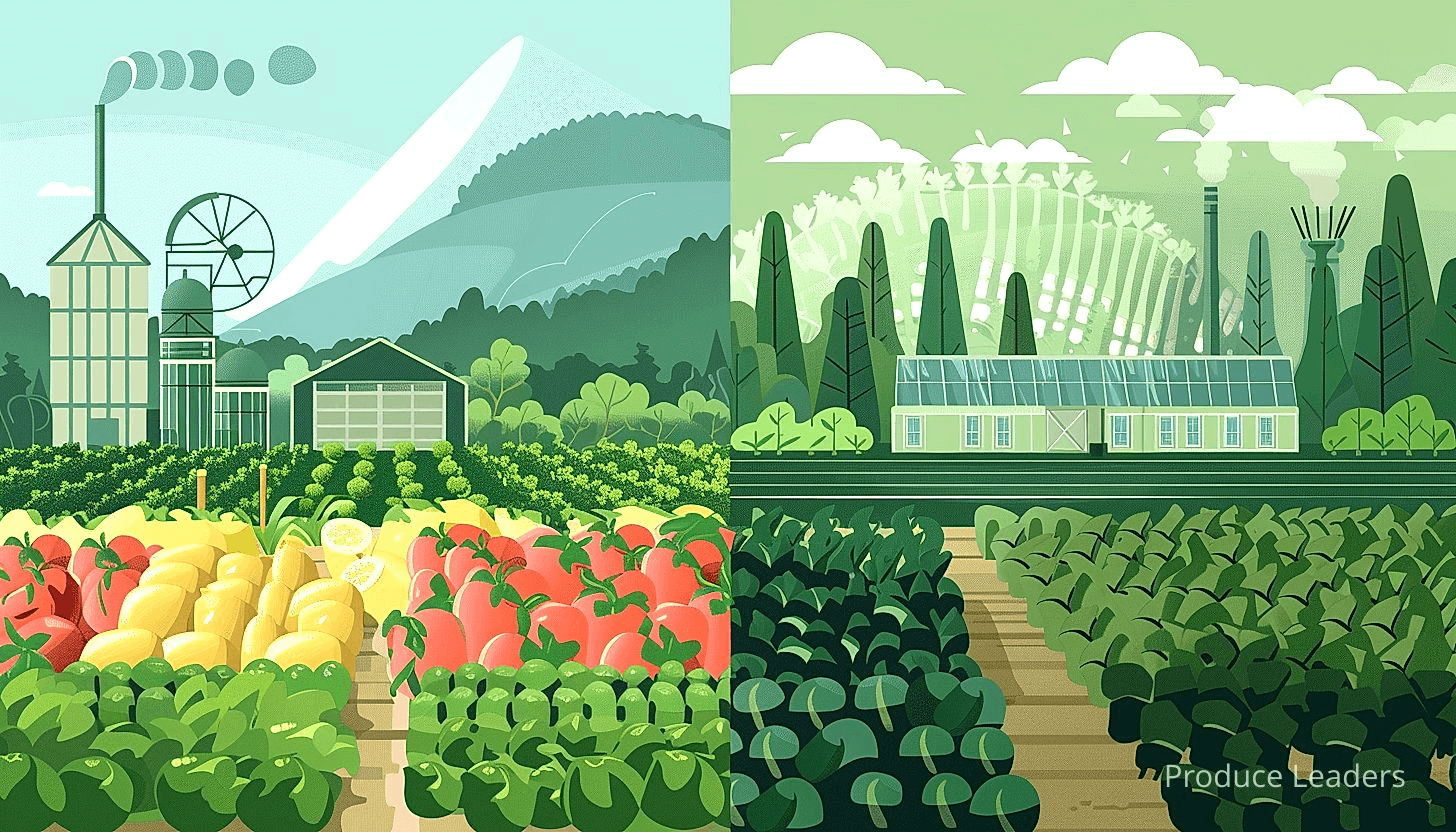
Organic farming abides by stricter regulations, to preserve the health of the soil and the ecosystems around it. Organic farmers often use more labor-intensive practices such as hand weeding, closed loop composting and cover cropping.
Let’s break this down further. The following are some significant factors driving the cost of organic produce:
- The inability to utilize economies of scale due to smaller operations
- Higher costs due to time-consuming manual labor practices
- The cost of obtaining and maintaining organic certification
- Additional costs of organic seeds and organic soil amendments
However, it’s also important to note the disparity in government funding. Are you aware that conventional farming tends to receive more government subsidies?
These subsidies help lower the cost of conventional produce. As a result, the price gap between organic and non-organic options only widens.
Now, let’s consider the consumer perspective. The high price tag of organic produce reflects a part of its true cost.
We may be paying more at the checkout, but purchasing organic also means supporting a farming system that’s more sustainable and safer for the environment and for farmworkers.
Furthermore, there’s baggage that comes with conventionally grown produce. The unaccounted ‘externalities’ such as the cost of pollution from pesticide runoff aren’t included in the final price tag, are they?
We need to realize that these costs are just shifted elsewhere, they still exist. Not only do they exist, but they’re also often shouldered by the public in the form of health issues and environmental clean-up costs.
Pro Tip: Though organic produce may come with a higher upfront cost, it supports a more sustainable and safer farming system for the environment and farmworkers, and takes into account factors often overlooked in conventional farming like the cost of pollution and health issues.
Though the up-front cost is higher, organic produce brings with it a level of responsibility and accountability. What does this imply?
It suggests that organic food prices represent more than just the produce. It’s about the labor, the process, the impact, and the VOICE towards a cleaner, safer world.
Can Conventional Farming Be Sustainable?
In Short: Conventional farming, often criticized for synthetic pesticide use and soil depletion, can adapt to become sustainable through methods such as integrated pest management, soil biodiversity, water-smart practices, and the adoption of economically viable sustainability measures. Proper assistance and incentives can facilitate this transition, leading to sustainable practices tailored for each farm’s specific context.
When discussing sustainability, we must understand that it encompasses several dimensions. These include social, economic, and environmental elements.
All sustainable farming methods strive to maintain long-term productivity and profitability. But can conventional farming methods offer the same promise?
It is essential to remember that sustainability isn’t a one-size-fits-all term. Different farming systems might achieve it in different ways. Does anyone consider whether conventional farming could adapt to fulfill sustainability criteria?
Conventional farming systems are often criticized for their synthetic pesticide use. Excessive pesticide application can contaminate groundwater, harm non-target organisms, and threaten human health. However, is it possible for conventional farming to transition to safer and fewer chemical inputs?
Contrary to popular belief, many conventional farmers are adopting integrated pest management strategies. These strategies utilize a balanced mix of chemical, biological, and physical methods. Such combination seeks to minimize the use and impact of synthetic pesticides.
Next, let’s consider the effects of conventional farming on soil health. Here will list the key impacts on soil and how conventional farming may address these.
For these factors, consider how conventional farming can improve:
- Soil degradation: Through conservation tillage and proper crop rotation, farmers can reduce soil erosion and improve nutrient cycling.
- Soil fertility: By incorporating organic matter into the soil and using cover crops, farmers can enhance soil fertility and productivity.
- Soil biodiversity: By minimizing pesticide use and practicing diverse cropping, farmers can preserve and promote a healthy soil ecosystem.
Another critical aspect to consider is water use. Conventional farming often depends on substantial water resources, leading to over-extraction. Can conventional farming transition towards more water-smart practices?
Many conventional farmers are already turning to precision irrigation and drought-resistant crops. These game-changing methods save water without sacrificing productivity. Is this the future of conventional farming?
Lastly, we consider economics. Conventional farms often operate on considerably thinner profit margins compared to their organic counterparts. Can these farms remain economically viable while transitioning to more sustainable practices?
Various studies have shown that sustainability measures can indeed increase profitability. They do this by decreasing input costs and enhancing crop resilience. But how easily can conventional farmers adopt these practices?
Some conventional farmers have already started transforming their operations. Slowly but surely, they’re integrating more sustainable practices into their systems. Isn’t it fascinating to see this shift?
Important: Sustainability in farming, which encompasses social, economic, and environmental elements, is not a one-size-fits-all concept, but with the appropriate assistance and incentive structures, even conventional farming practices can transition to achieve sustainable outcomes by adopting integrated pest management strategies, conservation tillage, proper crop rotation, water-smart practices, and other sustainable measures.
Let me tell you, can conventional farming be sustainable? Well, given the proper assistance and incentive structure, conventional farmers can effectively transition. This shift could yield sustainable practices suitable for their specific contexts.
Conventional farming, much like any system, has its own set of challenges. Yet, it’s clear that sustainability is within its reach. Is it not time we support these efforts, encouraging progressive change towards a more sustainable agriculture?
Factors Influencing Consumer Choices
In Short: Consumer choices between organic and conventional produce are influenced by a myriad of factors such as health consciousness, environmental impact, cost, taste, marketing, personal values and beliefs. These decisions, however, vary individually based on specific dietary needs, socioeconomic status and lifestyle.
What drives consumers to choose organic over conventional produce? Let’s explore some of the factors that come into play.
Health consciousness is a major player. Organic products are often considered healthier due to the absence of synthetic pesticides and fertilizers.
Are organic products truly healthier? The health benefits can differ greatly based on individual dietary needs and preferences.
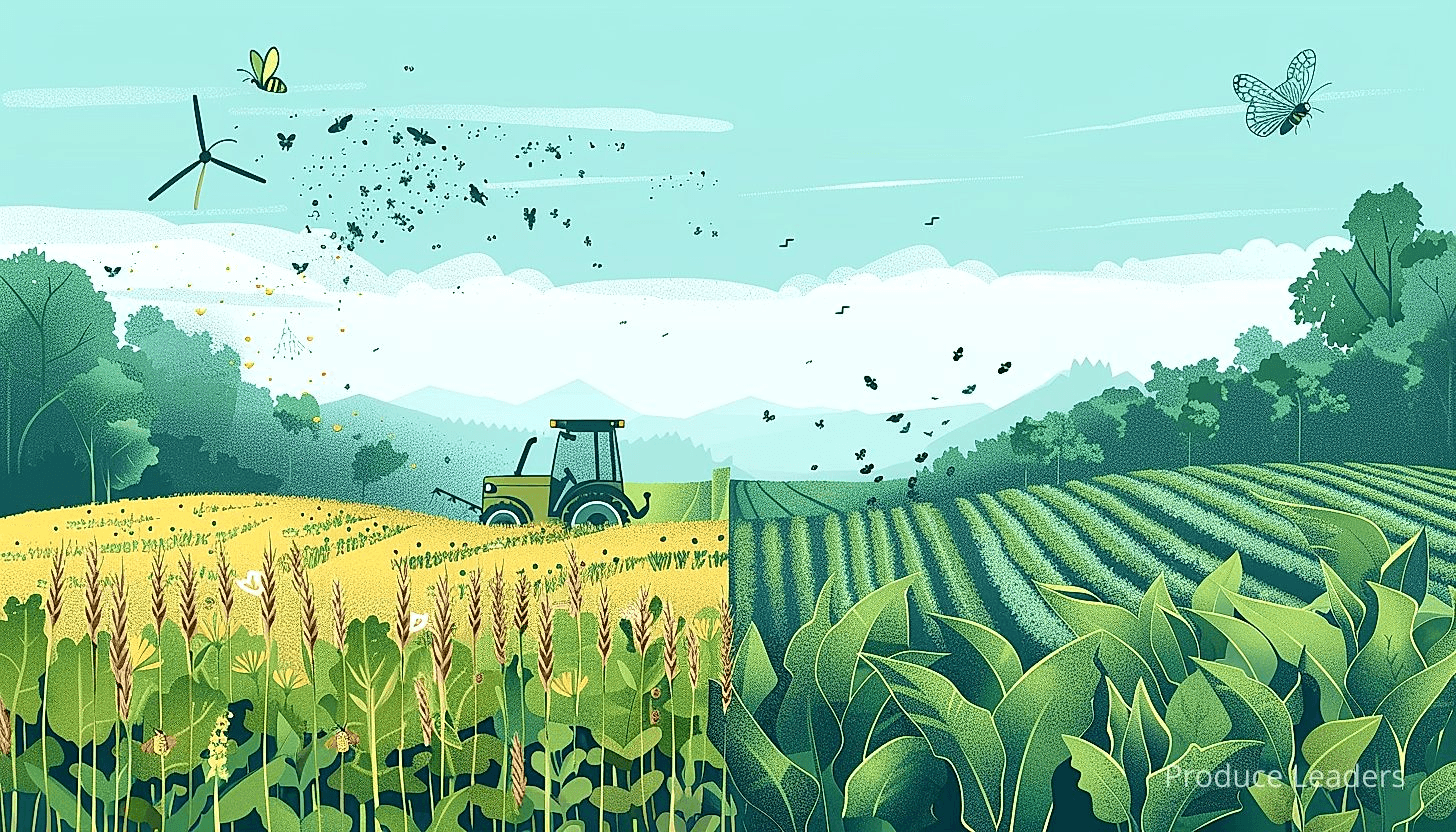
Moreover, the environmental impact of farming methods can also influence purchasing decisions. Many consumers pick organic products to support farming methods that have less negative impact on the environment.
Is organic farming as earth-friendly as we think? The answer becomes fuzzy once we dig in into details.
Now, let’s present the economics of organic and conventional produce. Costs play a considerable role.
- Organic produce is usually more expensive due to the higher cost of sustainable farming methods and limited production.
- For some consumers, the higher cost is justified by the perceived health and environmental benefits.
- On the other hand, conventional produce is less expensive and more widely available, making it an easier choice for many.
Presenting a clear relation of costs influencing organic and conventional produce choices:
The consumer’s socioeconomic status and budget constraints can also greatly influence decision-making. While some can afford to prioritize health and environmental factors, for others, cost may be the determining factor.
How about the taste factor? Do organic products taste better? Opinions vary, but some consumers believe that organic produce boasts superior flavor.
Next, let’s discuss the role of marketing and advertising. Crafty advertising messages and appealing packaging often sway consumer choices towards organic or conventional products.
Lastly, let’s not underestimate the power of human beliefs and values. Some consumers lean towards organic products because eating organic aligns with their personal values and lifestyle.
Pro Tip: Consider factors like health consciousness, environmental impact, economics, taste, marketing, and personal beliefs when making the choice between organic and conventional produce.
Similarly, personal beliefs can also influence a choice towards conventional produce. There are people who trust and prefer conventional farming methods as they have been established and in practice for many years now.
In a nutshell, the choice between organic and conventional produce is a complex issue. Numerous factors interact and dictate consumer behavior. What might be a compelling factor for you may not hold true for others. Isn’t it fascinating how varied our choices can be?
The Bottom Line
Organic produce is significantly defined by the absence of synthetic chemicals and genetically modified organisms, providing consumers with a cleaner and safer food option.
Choosing to consume organic produce offers several benefits including nutrient-rich food, fewer health risks associated with chemical consumption and positive contribution to a healthier environment.
In contrast, conventional produce, more often than not, contains harmful pesticides which not only pose health risks but also contribute to environmental degradation.
Looking critically at the nutrient values between organic and conventional food, organic options usually have higher nutritional content due to the healthier soil they are grown in.
The impact of organic farming on the environment is considerably lesser, as it encourages soil and water conservation and reduces pollution.
However, organic produce notably comes with higher cost compared to conventional food, creating an economic barrier for a fair amount of consumers.
When considering the long-term benefits to the environment and health, conventional farming could potentially become sustainable if it adapts environmentally friendly practices and significantly reduce chemical use.
Finally, consumer choices regarding organic versus conventional produce are influenced by various factors like their health values, environmental concerns, taste preference, and budget constraints.

